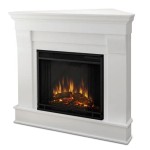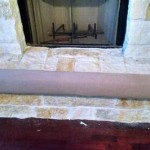Can You Redo A Fireplace? A Comprehensive Guide
A fireplace, traditionally the heart of a home, can become dated, inefficient, or simply clash with a new aesthetic. Redoing a fireplace, therefore, is a common home improvement project. The question of whether a fireplace can be redone is not a simple yes or no. It depends heavily on the scope of the project, the type of fireplace, existing structural integrity, local building codes, and budget. This article will explore the various aspects of redoing a fireplace, outlining the possibilities and considerations involved.
The idea of redoing a fireplace encompasses a wide range of potential changes. It could be as simple as painting the existing surround, or as complex as completely demolishing the existing structure and building a new one. Understanding the desired outcome is the first step in determining the feasibility of the project.
Before embarking on any work, a thorough assessment of the existing fireplace is crucial. This assessment should include the firebox, flue, hearth, surround, and any adjacent structural elements. Identifying any existing damage, such as cracks in the firebox, crumbling mortar, or a damaged flue liner, is paramount. Ignoring these issues can lead to safety hazards and costly repairs down the line. A qualified chimney sweep or building inspector can provide a professional assessment and identify any potential problems.
Furthermore, the type of fireplace will significantly influence the redoing process. Wood-burning fireplaces, gas fireplaces, and electric fireplaces each have their own unique considerations. Wood-burning fireplaces require careful attention to building codes regarding clearances to combustible materials and proper venting. Gas fireplaces necessitate working with gas lines, which should always be handled by a licensed professional. Electric fireplaces, while generally simpler, may still require electrical work and consideration of the surrounding wall structure.
Key Point 1: Assessing the Fireplace's Existing Condition and Type
The initial step in any fireplace renovation project is a meticulous evaluation. This involves determining the structural soundness of the existing fireplace and identifying its type, which dictates the scope and complexity of the undertaking. Cracks in the firebox, deteriorated mortar joints, and a compromised flue liner are common issues that must be addressed before proceeding. A professional inspection conducted by a qualified chimney sweep or building inspector is highly recommended to ensure a comprehensive assessment.
The fireplace type – wood-burning, gas, or electric – profoundly impacts the renovation process. Wood-burning fireplaces must adhere to stringent building codes regarding clearances to combustible materials and efficient venting. Gas fireplaces require the expertise of a licensed professional to handle gas lines safely and ensure proper installation. Electric fireplaces, while generally simpler in terms of fuel source, may still necessitate electrical work and structural modifications to the surrounding wall.
Consider the age of the fireplace. Older fireplaces may contain asbestos, particularly in the mastic used to adhere tiles or in the cement used in the flue. Disturbing asbestos can pose serious health risks, and its removal requires specialized procedures and licensed professionals.
The geographical location of the property also plays a role. Different regions have different building codes and regulations pertaining to fireplaces. Ensuring compliance with these codes is crucial for safety and to avoid potential legal issues. Researching local regulations and obtaining the necessary permits is an essential part of the planning process.
Key Point 2: Planning the Redesign and Considering Material Options
Once the existing fireplace has been thoroughly assessed, the next step is to plan the redesign. This involves determining the desired aesthetic outcome and selecting appropriate materials. The design should complement the overall style of the home and reflect the homeowner's personal preferences.
The material options for redoing a fireplace are vast and varied, ranging from natural stone and brick to tile, wood, and metal. Each material offers different aesthetic qualities, durability, and cost considerations. Natural stone, for example, provides a classic and elegant look but can be expensive. Brick offers a more rustic and traditional feel and is generally more affordable. Tile provides a wide range of design possibilities and is relatively easy to maintain. Wood can add warmth and character but requires careful consideration of fire safety. Metal can create a modern and industrial look but may require specialized installation techniques.
When selecting materials, it is important to consider their fire resistance. Materials used near the firebox must be non-combustible or treated with fire-retardant coatings. Building codes specify minimum clearances to combustible materials, which must be strictly adhered to.
Consider the overall scale and proportion of the new design. A fireplace that is too large or too small for the room can look out of place. Take measurements of the existing fireplace and the surrounding area to ensure that the new design is appropriately sized.
Think about the functionality of the fireplace. Will it be used primarily for aesthetic purposes, or will it be used to provide supplemental heat? If the fireplace will be used for heating, consider upgrading the firebox or adding a fireplace insert to improve efficiency.
Lighting is another important aspect to consider. Adding recessed lighting above the fireplace or sconces on either side can enhance its visual appeal and create a warm and inviting ambiance.
Key Point 3: The Importance of Professional Installation and Permits
While some fireplace renovation projects can be undertaken as DIY projects, it is generally advisable to hire qualified professionals for complex or structurally significant work. Working with gas lines, modifying the firebox, or altering the flue requires specialized skills and knowledge. Attempting these tasks without proper training can be dangerous and can lead to serious injury or property damage.
A qualified contractor can ensure that the renovation is done safely and according to building codes. They can also help with obtaining the necessary permits and inspections. Building permits are typically required for any structural modifications to a fireplace, and failing to obtain a permit can result in fines and delays.
When hiring a contractor, it is important to check their credentials and references. Make sure they are licensed and insured, and ask for examples of their previous work. Obtain multiple quotes from different contractors and compare their pricing and scope of work. A detailed contract should be drawn up outlining the project timeline, payment schedule, and responsibilities of each party.
The installation process will vary depending on the scope of the project. A simple surround replacement may only take a few days, while a complete fireplace rebuild can take several weeks. During the installation process, it is important to protect the surrounding area from dust and debris. Drop cloths should be used to cover furniture and flooring, and plastic sheeting should be used to seal off doorways.
After the installation is complete, a final inspection should be conducted to ensure that the work has been done correctly and that the fireplace is safe to use. A chimney sweep can inspect the flue and firebox for any potential problems. A gas professional can check for gas leaks and ensure that the gas appliance is functioning properly.
Following these guidelines can help to ensure a successful and safe fireplace renovation project. Redoing a fireplace can be a rewarding experience, adding value and beauty to a home. By carefully planning the project, selecting appropriate materials, and hiring qualified professionals, a homeowner can transform an outdated fireplace into a stunning focal point.
Adding to the above considerations, the question of whether to retain the existing footprint of the fireplace is crucial. Expanding the fireplace can dramatically alter the room's layout and may require significant structural modifications, potentially involving the relocation of walls or the reinforcement of the foundation. Conversely, reducing the size of the fireplace might free up valuable space but could diminish its visual impact and heating efficiency.
The type of fuel source also necessitates careful consideration. Converting from a wood-burning fireplace to a gas fireplace, for instance, involves installing a gas line, which requires compliance with local gas piping codes and regulations. Converting to an electric fireplace necessitates ensuring adequate electrical capacity to handle the increased load. Each conversion carries its own set of complexities and costs.
Accessibility is another key factor. If the fireplace is located in a hard-to-reach area, such as a small apartment or a multi-story building, the redoing process can be more challenging and expensive. Transporting materials and equipment to the site may require special arrangements and can increase the overall project cost.
The overall return on investment (ROI) should also be considered. While redoing a fireplace can enhance the aesthetic appeal and value of a home, it is important to weigh the cost of the project against the potential benefits. If the fireplace is not used regularly or if the home is not in a high-demand area, the ROI may be limited.
Finally, it's vital to document the entire process. Take before-and-after photos to showcase the transformation. Keep detailed records of all expenses, permits, and inspections. This documentation can be helpful for insurance purposes or if the home is ever sold.

10 Fireplace Makeover Ideas Before And After Regency
5 Amazing Inexpensive Easy Fireplace Remodel Transformations Designed

10 Fireplace Makeover Ideas Before And After Regency

10 Fireplace Makeover Ideas Before And After Regency

Beginner Friendly Diy Fireplace Makeover

Fireplace Update Before Afters Luce S Chimney Stove

Diy Fireplace Remodel Pt 1 Whitewashing Brick Custom Surround

Fireplace Update Before Afters Luce S Chimney Stove

Diy Fireplace Makeover At Home With The Barkers

Fireplace Makeover Before And After Sweet Tooth Life
Related Posts








